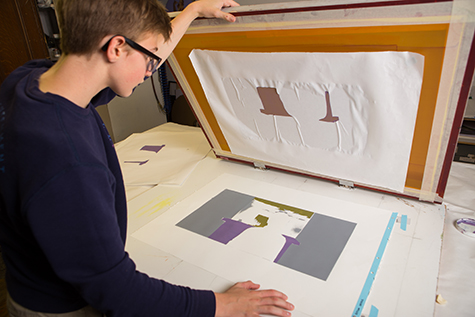ChatGPT said: How to get quick answers through 10:9 Design contact for your next order
The Vital Guide to Recognizing Screen Printing and Its Versatile Utilizes
Screen printing has a rich background that goes back to ancient times, progressing into an advanced strategy utilized throughout numerous markets today. This overview checks out the details of the screen printing process, outlining its applications in advertising, fashion, and home decoration - 10:9 Design Screen Printing Texas. Comprehending these fundamentals can open imaginative capacity for both artistic and business jobs. The adhering to areas will certainly expose necessary pointers and strategies to boost one's screen printing ventures
The Background of Screen Printing
Although screen printing has origins that map back centuries, its advancement mirrors the technical and imaginative advancements of numerous cultures. Originating in old China, the technique was initially used for embellishing textiles and later spread to Japan, where it came to be indispensable to Ukiyo-e woodblock printing. The approach changed to Europe in the 18th century, where it gained appeal amongst craftsmens and industrial printers. The development of image solution in the 20th century reinvented screen printing, enabling for even more intricate layouts and higher effectiveness. Artists like Andy Warhol even more propelled its appeal, using the tool to produce iconic jobs that mixed commercialism and art. By the late 20th century, screen printing had actually established itself as a functional method, employed in style, advertising and marketing, and great art. Today, it continues to advance, integrating electronic modern technology and broadening its applications across various industries.
The Screen Printing Process Explained
Screen printing transforms artistic visions into tangible designs via a series of accurate actions. A picture is produced and then transferred onto a screen, normally made of great mesh textile stretched over a framework. A light-sensitive emulsion is put on the screen, which is subjected to light, setting in locations not covered by the picture. After rinsing the unhardened solution, a pattern is formed.
Next off, the screen is put over the substrate, whether it be material, paper, or an additional material. Ink is then pushed through the open areas of the stencil using a squeegee, transferring the style onto the substrate below. This process can be repeated for several shades, needing different displays for each and every shade. The printed item is cured using heat to ensure the ink adheres properly, resulting in a sturdy, vivid design prepared for use.
Kinds Of Screen Printing Techniques

Furthermore, specialized techniques, such as discharge screen printing, remove dye from the textile to create softer prints, while aluminum foil screen printing applies metallic foil to achieve a shiny surface (10:9 Design reviews). Each method supplies distinctive qualities, accommodating different innovative requirements and manufacturing scales, ultimately expanding the opportunities within the screen printing domain
Applications of Screen Printing in Numerous Industries

In addition, the signs and advertising and marketing sectors utilize screen printing for producing appealing displays and banners. This method permits vibrant shades and elaborate layouts that catch interest. get more info In electronics, screen printing is used for applying conductive inks to motherboard, necessary for element links. Additionally, the home design sector embraces screen printing to create unique styles on textiles and wall surface art. Overall, screen printing works as an important device across varied areas, improving items with customized and visually enticing graphics.
Tips for Successful Screen Printing Projects
While taking on a screen printing task, cautious interest to information can substantially enhance the final end result. Choosing top quality materials is crucial; this includes the screen, inks, and substrates. Utilizing proper mesh counts can influence ink deposition and information resolution. Preparation is equally crucial; extensive cleaning of displays and proper direct exposure times ensure crisp prints.
Next off, accurate enrollment is important for multi-color prints. Making use of alignment tools can assist accomplish exact layering. In addition, screening prints on scrap materials prior to production aids recognize prospective issues without losing sources.

Regularly Asked Concerns
What Materials Are Finest for Screen Printing on Textile?
Cotton and polyester blends are excellent for screen printing on textile due to their longevity and ink absorption. Furthermore, specialized materials like silk or canvas can produce distinct structures and coatings, boosting the overall style top quality.
Exactly how Do I Clean and Maintain Screen Printing Tools?
To clean and preserve screen printing tools, one must consistently clean screens with suitable solvents, examine mops for wear, lube relocating parts, and shop all items in a completely dry, dust-free setting to prolong their lifespan.
What Are the Ecological Influences of Screen Printing?
Screen printing can have significant ecological influences, consisting of chemical waste from inks and solvents, water use during cleansing procedures, and power usage. Sustainable techniques and green materials are necessary for minimizing these unfavorable effects.
Can Screen Printing Be Done at Home Efficiently?
Screen printing can be effectively done at home with the ideal materials and techniques. Enthusiasts can produce top quality prints, though success depends upon their ability degree, devices, and understanding of the process included.
What Are the Costs Connected With Beginning a Screen Printing Service?

Starting a screen printing business entails expenses for tools, products, and workspace. First costs normally vary from a couple of hundred to several thousand dollars, depending on the scale, quality of equipment, and preferred production capacity.
Screen printing has an abundant history that dates back to old times, advancing into an innovative technique utilized across numerous sectors today. Another technique, rotary screen printing, employs round screens, helping with continual printing on textile rolls, therefore enhancing performance for massive manufacturings. Furthermore, specialized strategies, such as discharge screen printing, remove dye from the fabric to develop softer prints, while foil screen printing uses metal foil to accomplish a glossy surface. In the fashion sector, screen printing is widely made use of to produce lively layouts on clothing, enabling brands to showcase their distinct styles. Cotton and polyester blends are suitable for screen printing on material due to their sturdiness and ink absorption.